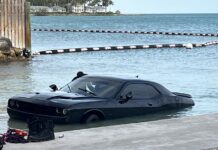Twenty-five years ago, on July 20, 1998, the Carnival cruise ship Ecstasy lost power after a small fire ignited in the ship’s laundry as she was departing Miami en route to Key West.
Catastrophe was avoided because of the crew, and more so the immediate assistance rendered from shore.
But would the outcome have been the same if the fire had occurred when the Ecstasy was leaving Key West? In the last 25 years, as ships have gotten bigger, what have we done here in Key West to prepare for a similar event? What is our ability to deal with a large, ship-borne emergency?
This is not an academic question. Most of my career was spent planning for and responding to crises, especially those involving loss of life: tsunamis, earthquakes, hurricanes, aircraft crashes, terrorist attacks, rail crashes and ship losses.
The fire onboard the Ecstasy is a perfect planning exercise and test for Key West. There were 2,565 passengers and 916 crewmembers on board. At 5:10 p.m., with the port pilot still on board and the Ecstasy still in the channel, a fire started in the laundry room. Within minutes the fire had quickly spread to surrounding work areas of the ship. At 5:54 p.m. the Ecstasy lost propulsion and steering. At 6:15 p.m. a Coast Guard team arrived. At 6:27 p.m. the tug Coastal Key West started directing water on the stern. By 7:13 p.m. a total of five tugboats and one Coast Guard utility boat arrived and either sprayed water on the ship or helped control its movement. At 7:50 p.m. shoreside firefighters boarded the ship. At 9:09 p.m. Miami Dade Fire Department declared the fire under control. At 9:30 p.m. the Ecstasy was allowed to re-enter the port. It was towed back and docked at 1:18 a.m. on July 21.
What if the Ecstasy had caught fire while departing Key West? That is a big what-if, but a completely reasonable question that should be planned for.
In Miami, the responding boats were all large vessels. The last Key West-based large tug that could help in an event like this was the 207-foot Resolve Pioneer with towing and firefighting equipment. It was stationed here in 2010. It is now in Alaska.
Another critical shore-based asset were the two local fire departments that deployed trained strike teams and a hazardous material team from Miami Dade monitored the Ecstasy for carbon monoxide.
Key West and Monroe County do a lot to prepare for hurricanes and other disasters. We have great fire departments in the city and county, along with the police, sheriff’s office, state and federal agencies. But when it comes to addressing a clear and realistic threat concerning our port, I think we’ve glossed over a realistic plan. Such large incidents are often thought to be someone else’s responsibility.
Our top-notch first responders do a lot of training and exercises: active shooter drills, confined space rescue and hazardous material response. Our local fire department is an ISO Class 1-certified fire department. Is all that sufficient for a cruise ship incident? No.
For something like the Ecstasy fire, local fire departments should train to the National Fire Protection Association (NFPA) 1405 – Guide for Land-Based Firefighters Who Respond to Marine Vessel Fires and meet the NFPA 1925 standard on Marine Fire Fighting Vessels.
Geography and resources favored Miami in this case. It’s quite the opposite here. If we follow the same sequence – the ship loses power and drifts — given the size of ships visiting Key West, it is logical that a large drifting ship will quickly become grounded, potentially blocking the channel.
Depending on wind direction, smoke (and heat) could be driven further into the ship creating injuries or fatalities, or towards the city creating a need to shelter in place. A ship lodged in the channel could also block all other vessels from responding to help. The results could be catastrophically different from the Ecstasy — loss of life, injury, environment damage and liability for the city, to name a few.
Fires on cruise ships are not common, but they are not unheard of. If we accept the benefit of that business, we accept the risk. I suggest we start addressing ways to mitigate that risk, including training for responders, equipment, and, as part of the contracts for port access, insist on full insurance coverage for response costs, which airlines have. The initial costs should also be funded by those who earn income from the business.
Whether you like cruise ships or not, they are part of Key West, they provide income to the city, and are permitted by state law. I am not advocating for their removal, increase or the status quo. I am asking what the plan is to deal with a foreseeable consequence at the port.
In the case of the Ecstasy, 22 people were treated for minor injuries and one person suffered serious injury. The ship suffered $17 million in damage. From a crisis management standpoint, it was a very successful response. That was not luck, it was training, combined with resources based on potential hazards.
Robert A. Jensen is formerly the chairman and owner of Kenyon International Emergency Services. He responded to and managed crises, including multiple air crashes, maritime and rail accidents, natural disasters such as hurricanes, tsunamis, the Haitian earthquake; terrorist attacks and catastrophic fires. He has also published two books and is a subject matter expert for media, and quoted internationally. He and his husband reside in Key West.























